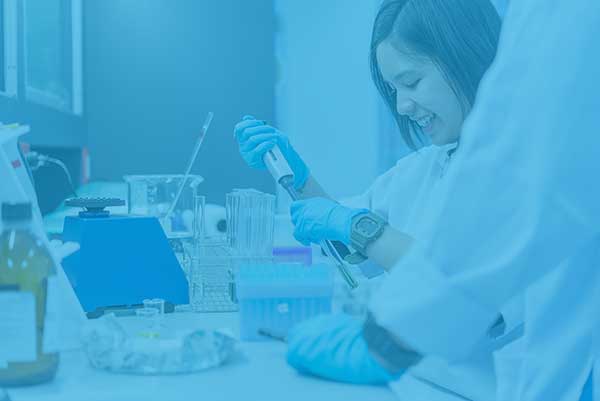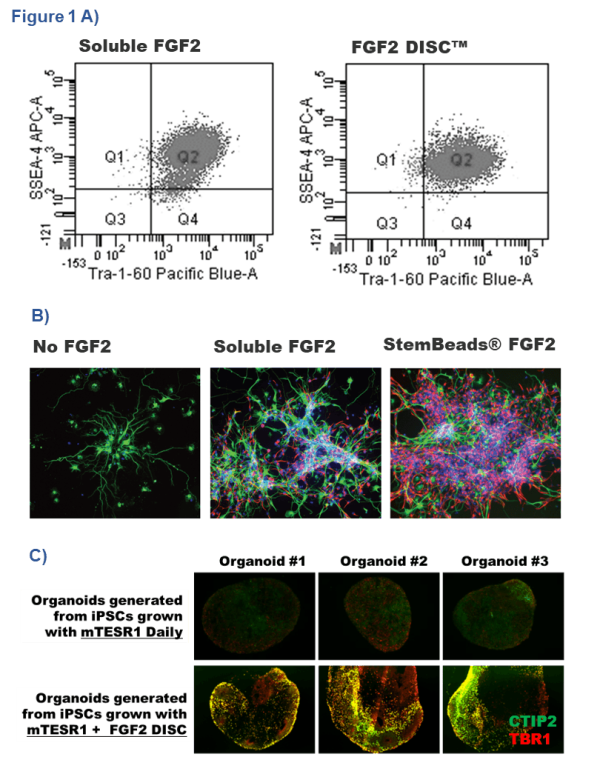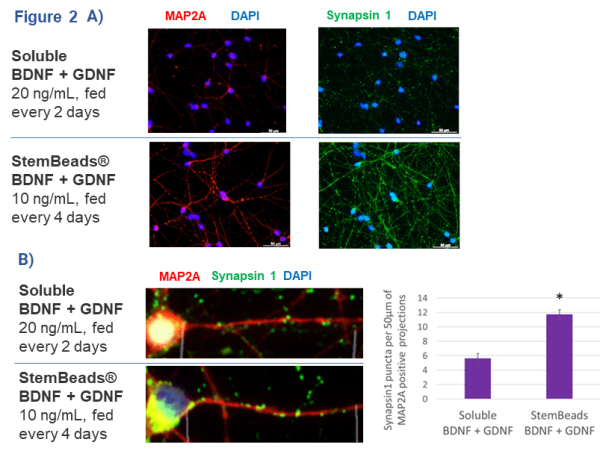SUCCESS, TOGETHER
StemCultures stem cell culture media additives have been used by iPSC core facilities, academic institutions, and biotechnology companies. We have served over 700 research scientists in over six countries.
Our scientists are available to help you choose controlled-release growth factor products that will benefit your cell cultures.
Choose StemBeads or DISC Devices for stem cell culture media.



Problem
For example, FGF2 has a half-life of 4-5 hours in culture media in the incubator. To compensate for this rapid decline, high levels (approx. 100 ng/mL) of soluble factor are included in many commercial media and daily feeding is often recommended. Even with these daily medium changes, the level of FGF2 dips below the 5-10ng/mL level needed to prevent human pluripotent stem cell differentiation. The resulting large daily fluctuations in FGF2 levels cause irregular cell signaling and cell behaviors, often seen as spontaneous differentiation.
Solution
To achieve stable FGF2 signaling and more reliable cell behavior, StemCultures has developed controlled-release growth factor technology in the form of biodegradable microbeads and nondegradable DISC™ devices. These provide a constant growth factor level, reduce feeding schedules, and improve cell quality. Using controlled-release growth factor technology saves time and money while producing more consistent, higher quality culture outcomes that improve downstream differentiation efficiencies.
KEY FINDING
The cellular environment is no longer stressed by large fluctuations in growth factor levels, producing better, more consistent cultures.
Controlled-release FGF2 enhances pluripotency markers, reduces unwanted spontaneous differentiation, improves downstream differentiation efficiency, and improves iPSC derived organoids.

Figure 1. A) hPSCs grown with FGF2 DISCs show increased pluripotency markers SSEA4 and Tra-1-60 compared to daily media feeds of soluble FGF2 by flow cytometry. B) Mouse neuronal stem cell growth for one week in StemBeads® FGF2 show increased progenitor cells (Nestin+) and decreased neuronal differentiation (TUJ1+) compared to no FGF2 and soluble FGF2. C) iPSC lines that did not generate well-patterned cerebral organoids after growth with daily mTeSR1 were recovered by switching to growth in mTeSR1 with an FGF2 DISC™. Correctly patterned organoids express cerebral markers CTIP2 and TBR1 at 2 months.
Controlled-release BDNF and GDNF increases MAP2A-positive axonal projections, enhances dendritic arborization, and increases Synapsin1 co-localization with MAP2A positive cortical neurons.

Figure 2. Immunofluorescent images of human iPSC derived forebrain neurons stained with mature neuron marker MAP2A (red), pre-synaptic marker synapsin1 (green) and nuclear dye DAPI (blue). Neurons were differentiated with 20 ng/mL soluble growth factors fed every other day (top row) compared to 10 ng/mL of controlled-release StemBeads® fed every 4 days (bottom row). A) Neurons generated with StemBeads® had increased MAP2A mean fluorescent intensity. B) Neurons generated using StemBeads® and fed less often significantly (P < 0.05) increased the colocalization of pre-synaptic marker synapsin1 with MAP2A.
Do you need custom products with proteins not listed? We have successfully encapsulated other growth factors, and will quote the manufacturing of these proteins. There will be an extended lead time for manufacture as we do not keep these in stock.